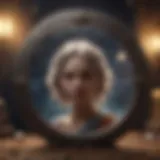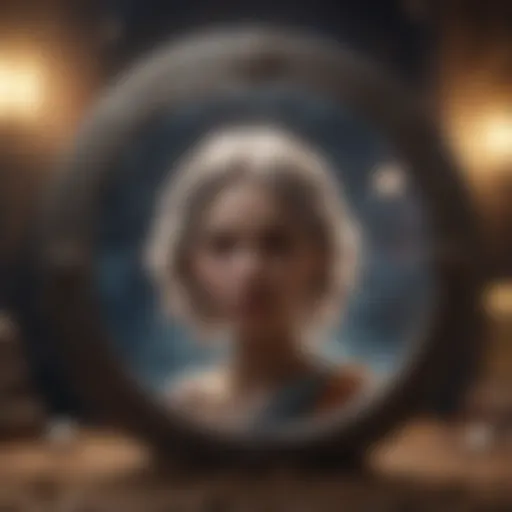Selecting a Tarot Deck: A Beginner’s Guide
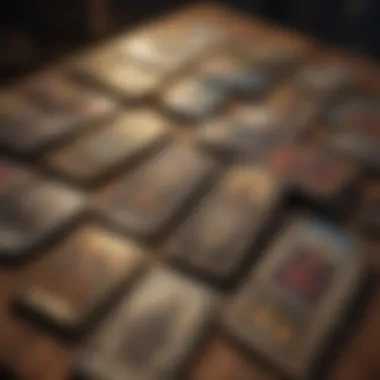

Intro
Selecting the right tarot deck for beginners can be both an exciting and overwhelming experience. With countless options available, new users often feel lost in a sea of designs and themes. Each deck not only varies in art style but also carries unique symbolism that can significantly influence one's tarot practice.
This article aims to clarify the essential attributes to consider when selecting a tarot deck. It will examine the diverse types of tarot decks, the factors that play a crucial role in selecting one, and provide helpful tips for those just starting their tarot journey. By understanding these essential aspects, readers can make an informed choice that aligns with their personal exploration of tarot.
Types of Tarot Decks
When venturing into the world of tarot, it’s crucial to understand the variations in deck types. The traditional Rider-Waite-Smith deck is often recommended for beginners due to its straightforward imagery and established meanings. However, other styles also cater to different tastes and needs.
- Rider-Waite Tarot: This classic deck is renowned for its rich symbolism and ease of understanding.
- Thoth Tarot: Created by Aleister Crowley and Lady Frieda Harris, this deck is more esoteric and may appeal to advanced users.
- Lenormand: A distinct system that utilizes different cards, focusing on everyday life.
- Oracle decks: Unlike traditional tarot, these decks can vary widely in design and don't follow a strict structure.
Factors to Consider in Selection
Making a selection goes beyond just picking a beautiful deck. Here are important factors to keep in mind:
- Art Style: The visuals should resonate with you personally. Choose designs that evoke a sense of connection.
- Symbolism: Different decks carry varying meanings attached to their symbols. Look for one that reflects your understanding and beliefs.
- Usability: Some decks may come with accompanying guidebooks while others require more intuitive interpretation.
- Size and Quality: Consider if you prefer smaller, portable decks or larger ones for readings. Higher quality cards will withstand repeated use.
Tips for First-Time Users
If you are new to tarot, the following tips can enhance your initial experiences:
- Begin with a Guidebook: Most decks come with a guidebook. Familiarize yourself with it, as it provides valuable insights into the card meanings.
- Start Simple: Begin with a one-card pull to get comfortable interpreting individual cards before moving on to spreads.
- Reflect on Your Readings: Keep a journal to note your impressions of each reading. This helps build your intuition over time.
- Practice Regularly: The more you work with your deck, the more you will sharpen your skills.
Choosing a tarot deck is a personal journey. The right deck should resonate with your intuition, provide you joy, and serve as a tool for deeper self-exploration. As you engage with your chosen tarot deck, you will discover which styles and techniques align with your understanding of the tarot.
"Tarot is not just about predicting the future; it is about understanding the present."
By keeping these considerations and tips in mind, you will be better equipped to embark on your tarot journey with confidence.
Understanding Tarot Cards
Understanding Tarot cards is paramount for anyone interested in delving into the world of Tarot. It forms the foundation upon which a beginner can build their practice and comprehension. Knowing the basics can clarify the significance of the cards, the nuances of reading them, and ultimately enhance the experience of using a Tarot deck. This section will cover essential elements such as the definition, historical context, and structural composition of a Tarot deck. Readers will be better equipped to select a deck and utilize it meaningfully when they grasp these concepts.
Definition of Tarot
Tarot is a deck of cards traditionally used for divination, self-reflection, and exploration of the human experience. Each card has specific imagery and symbolism, presenting a unique narrative when combined with others in a reading. The cards can serve as a mirror reflecting one's thoughts, feelings, and circumstances. It's essential for beginners to understand that Tarot is not merely a tool of fortune telling but a means to insight and personal discovery.
History of Tarot Usage
The history of Tarot dates back to the 15th century, believed to have originated in Italy. Initially, the cards were used for games rather than divination. Over time, mystics and scholars adapted Tarot for spiritual purposes. The decks became both a method of storytelling and a source of guidance. Understanding this evolution adds depth to the practice, revealing how Tarot has transformed to suit the needs of various cultures throughout the centuries.
Structure of a Tarot Deck
A standard Tarot deck consists of 78 cards divided into two main categories: the Major Arcana and the Minor Arcana. This structure allows the deck to address both significant life themes and everyday challenges.
Major Arcana
The Major Arcana contains 22 cards, each representing key life lessons and archetypes. These cards are fundamental in a reading as they signify significant events and spiritual truths. Examples include The Fool, representing new beginnings, and The World, symbolizing completion and fulfillment. The prominence of Major Arcana cards in a spread indicates profound influences in the querent's life. Their symbolism often provides deeper insights compared to other cards, making them a favored area of focus.
Minor Arcana
The Minor Arcana consists of 56 cards that delve into the details of daily life. It is divided into four suits, similar to playing cards: Wands, Cups, Swords, and Pentacles. Each suit addresses specific aspects of life, such as creativity, emotions, intellect, and material issues, respectively. The presence of Minor Arcana cards can elaborate on the context of a situation already hinted at by the Major Arcana. Understanding this division is crucial as it helps in the interpretation of readings, enhancing the reader's clarity on minor yet significant matters.
Court Cards
Court Cards include 16 cards found within the Minor Arcana, representing people or personality traits. They are divided into four types: Page, Knight, Queen, and King, mirroring the suits. These cards are essential as they can represent either individuals in the querent's life or aspects of the querent’s personality. The Court Cards provide an opportunity to explore nuanced dynamics in relationships and individual behavior, enhancing the reading’s depth and scope.
"The understanding of Tarot cards and their structure lays the groundwork for insightful readings and means to connect with one’s self."
This section emphasizes the necessity of comprehending Tarot as a complete system. Each component—from definitions to historical context—unveils the complexity and beauty of Tarot practice, setting the stage for effective deck selection.
Types of Tarot Decks
In the journey of selecting a tarot deck, it is crucial to understand the various types available. Each deck has unique designs, themes, and interpretations. Understanding these differences helps beginners to find a deck that resonates with their personal style and intended use. The right choice can enhance the reading experience, making it more intuitive and meaningful.
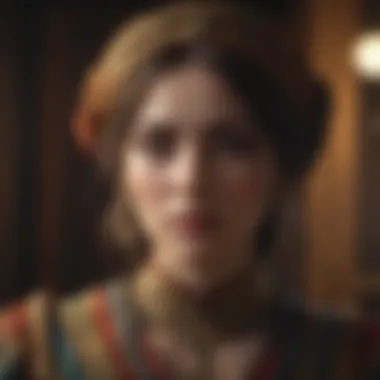

Traditional Tarot Decks
Traditional tarot decks usually consist of well-established designs and are rooted in historical significance. Two notable examples are the Rider-Waite-Smith and Thoth Tarot decks. Each of these decks comes with particular strengths and interpretations that contribute to their popularity among users.
Rider-Waite-Smith
The Rider-Waite-Smith deck is perhaps the most famous tarot deck. Its iconic imagery is a staple in tarot reading. This deck stands out due to its clear symbolism and accessible art. It was created in the early 20th century by Arthur Edward Waite and illustrated by Pamela Colman Smith.
The key characteristic of this deck is its imagery, which is often straightforward and easy to interpret for beginners. This accessibility makes it a beneficial choice for those new to tarot. The rich symbolism linked to each card facilitates a deeper understanding of tarot meanings.
A unique feature of the Rider-Waite-Smith deck is its focus on the narrative aspect represented in the cards. Each card tells a story, making it easier for readers to connect with their personal experiences during readings. The only disadvantage could be that its popularity might lead some to view it as too standard or clichéd.
Thoth Tarot
The Thoth Tarot, created by Aleister Crowley and painted by Lady Frieda Harris, presents a more esoteric approach to tarot. Its complex and rich symbolism draws from various philosophies including astrology, Kabbalah, and alchemy.
The key characteristic of the Thoth Tarot is its intricate symbolism and focus on the deeper, sometimes darker, aspects of human experience. This complexity can provide valuable insights, appealing to those who seek to explore the more profound layers of tarot interpretation. Thus, it is a popular choice for users interested in a more detailed understanding.
One unique feature of this deck is its use of vibrant and often unconventional imagery. This may create challenges for beginners in interpreting the cards. The advantage, however, is that it encourages users to engage deeply with each card’s meaning and explore personal insights.
Modern Interpretations
The evolution of tarot has led to a surge in modern interpretations of traditional decks. These contemporary decks often reflect current cultural themes and artistic styles. Two prominent categories include graphic novels and artistic variations.
Graphic Novels
Graphic novels as tarot decks bring a fresh and modern twist to the traditional form. They often incorporate narrative storytelling, vibrant colors, and contemporary art styles that appeal to a diverse audience.
The key characteristic of graphic novel decks is their artistic representation, which blends the tarot structure with narrative art forms. This can be particularly appealing for younger generations or those who appreciate graphic storytelling. By merging familiar comic styles with tarot, these decks can make learning about tarot more engaging.
A potential advantage of using a graphic novel deck is that it can provide a relatable context for the meanings of the cards. However, their uniqueness may also confuse users who are accustomed to traditional imagery, making initial interpretations more challenging.
Artistic Deck Variations
Artistic deck variations encompass a wide range of unique interpretations. These decks often feature themes related to nature, fantasy, or specific artistic styles, catering to various aesthetic preferences.
The key characteristic of these decks is their diverse themes and artistic expressions. This variety allows users to choose a deck that resonates with their personal beliefs and tastes. For beginners, it can also serve as an avenue for exploring different aspects of tarot through art.
A unique feature of artistic decks is that they can evoke strong emotional responses. The photos or illustrations may feel deeply personal, enhancing the connection between the user and their readings. While they can foster intuition and emotional insight, it can also distract from traditional meanings, which might require careful study.
Oracle and Specialty Decks
Oracle decks differ from traditional tarot but offer an accessible entry point for beginners. They often focus on specific themes, delivering messages that are intended to inspire and guide rather than predict the future. Specialty decks may also cater to targeted audiences, providing unique artistic or spiritual findings. This section will examine how these decks fit into the broader landscape of tarot, discussing both their purpose and appeal.
Choosing Your First Tarot Deck
Choosing your first tarot deck is a pivotal step in your exploration of tarot. The right deck can enhance your understanding of the cards and deepen your intuitive connection. For a beginner, this process can be overwhelming, given the multitude of options available. Factors like imagery, card size, and personal resonance all play significant roles in this decision-making process. This section guides you through these vital elements to help you select a deck that aligns with your intentions and enhances your tarot practice.
Assessing Your Intuition
Your intuition is a powerful guide when choosing a tarot deck. It is essential to trust your feelings and reactions to different decks. When browsing, pay attention to what resonates with you. A deck that speaks to your emotions can significantly impact your tarot journey.
Handling different decks in person can be especially beneficial. As you touch the cards, notice the energy they emit. This simple act of connection can clarify if a deck is suitable for you. Online images sometimes don't convey the true essence of a deck. Therefore, if possible, visit local metaphysical shops or tarot fairs.
Considerations for Imagery
Imagery is a fundamental aspect of a tarot deck. Each card carries unique symbols and illustrations that affect interpretation. When selecting your first deck, examine each card closely. Are the images vivid and appealing to you? Do they evoke the right emotions or thoughts?
Each deck offers a different artistic style. The Rider-Waite-Smith is known for its accessible imagery, which is beneficial for beginners. Thoth Tarot, on the other hand, offers more complex symbolism, which might appeal to those looking for deeper analytical layers. Also, consider whether you prefer modern or traditional designs.
Imagery should inspire you to engage with the cards. A visually pleasing deck can make your reading sessions more enjoyable and insightful.
Size and Quality of Cards
The size and quality of the cards are often overlooked but critical factors. Larger cards may be more challenging for some to shuffle and handle. The texture and finish of the cards provide tactile feedback, impacting how they feel during use.
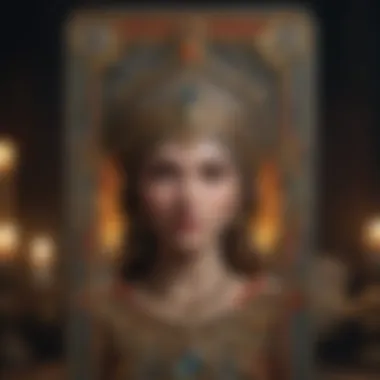

A standard tarot card size is about 2.75" x 4.75", but other sizes exist. Explore how different sizes fit in your hands. A good quality deck is one that withstands frequent use without wear. Look for decks made from durable materials.
In summary, while aesthetics and personal connection are essential, consider the functionality of the deck as well.
Key Takeaway: Your first tarot deck should resonate with you on a personal and intuitive level. Assessing your feelings about the deck, imagery, and card quality will guide you towards a selection that serves you well in your tarot journey.
Practical Tips for Beginners
Navigating the realm of tarot can be quite overwhelming for newcomers. This section aims to demystify some essential practices that can make your journey more enriching and insightful. By adopting practical tips, beginners can develop a profound connection with tarot cards, enhancing their understanding and proficiency. The importance of these tips lies not just in learning how to read the cards, but also in cultivating a personal relationship with them, as tarot is as much an intuitive art as it is a structured system.
Familiarizing with Card Meanings
A fundamental step in tarot practice is to familiarize oneself with the meanings of the cards. Each card holds rich symbolism and various interpretations, which can differ based on context. Beginners should start by selecting one deck and studying it closely.
Consider using the following methods:
- Dedicated Note-taking: Keep a tarot journal. Note your interpretations as you draw each card. This will help reinforce meanings and can serve as a reference.
- Flashcards: Create flashcards with images of the cards on one side and keywords or phrases on the other. This helps in memorizing meanings and supporting quicker recall during readings.
- Daily Reflection: Draw a single card daily and reflect on its relevance to your day. This personal application will deepen your understanding.
Understanding Layouts and Spreads
Layouts or spreads are essential tools in tarot reading. They determine how the cards are arranged and the messages that can be interpreted from them. Beginners should explore various layouts to comprehend how they influence readings. Common spreads include:
- Single Card Draw: Useful for quick insights or daily guidance.
- Three-Card Spread: Often representing the past, present, and future; this spread allows for more nuanced readings.
- Celtic Cross: A more complex layout that provides comprehensive insights into a situation or question.
Choosing the right spread is crucial. It should align with your question or intention. Spend time practicing different layouts, taking note of how card positions impact their meanings.
Daily Card Draws for Practice
Incorporating daily card draws into your practice is a simple yet effective method for growth. By setting aside a few moments each day to draw a card, beginners can immerse themselves in the material slowly. Here are some advantages of this practice:
- Consistency: Regular pulls nurture a habit, embedding card meanings in your consciousness.
- Intuition Development: Daily draws foster intuitive insights about card symbolism and personal relevance.
- Tracking Progress: Maintain a log of your daily draws in your journal. Record thoughts, feelings, and events related to the card to observe patterns over time.
By following these practical tips, beginners in the tarot community can lay a strong foundation. This approach, focusing on familiarization, understanding of layouts, and daily practice, will enrich the tarot learning journey significantly.
"Tarot is a mirror reflecting your inner knowledge."
Embrace these techniques with patience, and over time, you will find your readings resonate more deeply with your experiences and insights.
Community and Resources
Engaging with a community can be invaluable for anyone starting their tarot journey. The support and knowledge shared among enthusiasts and knowledgeable practitioners can greatly enhance the learning experience. Joining like-minded individuals provides opportunities for sharing insights, exchanging experiences, and receiving guidance.
In addition, resources such as books, online tutorials, or forums offer access to a wider range of information that can supplement and deepen one's understanding of tarot. This section will explore how to get involved with tarot communities as well as useful materials and prominent figures in the field.
Joining Tarot Groups
Being a part of tarot groups can significantly benefit beginners. These groups often host meetings, workshops, and discussions which encourage interaction among members. In a group setting, individuals can ask questions, seek advice, and share personal interpretations of tarot cards. This not only builds confidence but also helps clarify concepts that might be unclear.
Online platforms, such as Facebook and Reddit, host various tarot communities. Engaging in these forums can provide immediate feedback and support, helping to demystify the learning process. Often, members share their personal experiences and card interpretations, which can greatly influence one's understanding of different tarot systems.
Another approach is to look for local meetups. Many areas have tarot enthusiasts who meet regularly to practice readings and discuss different decks and spreads. Connecting in person fosters a stronger sense of community and provides direct mentorship opportunities which can be very beneficial.
Books and Online Resources
Books are a fundamental resource for tarot learning. They offer comprehensive insights into card meanings, spreads, and the history of tarot. Popular titles include "The Ultimate Guide to Tarot" by Liz Dean and "The Tarot Bible" by Sarah Bartlett. These works not only present foundational material but also explore diverse perspectives on tarot interpretation.
Online platforms also provide a wealth of information. Websites such as Wikipedia and Britannica offer informative articles detailing the history and structure of tarot. Additionally, tarot-focused blogs often contain tutorials, card readings, and personal stories that enhance understanding. Many YouTube channels provide visual content that can make learning more engaging.
Furthermore, apps dedicated to tarot can offer daily card draws, meanings, and journaling options. These tools can help track progress and build a consistent practice.
Prominent Tarot Readers to Follow
Following seasoned tarot readers can provide inspiration and insights. Many professional readers maintain social media profiles or personal websites where they share readings, educational content, and interpretations of different tarot decks.
Some noteworthy tarot readers include:
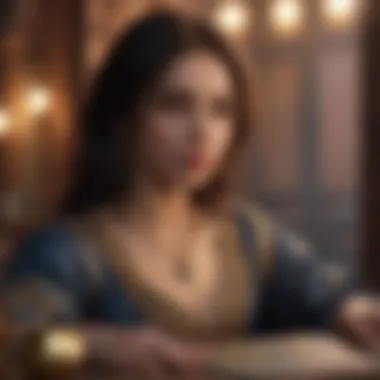

- Rachel Pollack: Renowned for her depth of knowledge and engaging writing style.
- Katherine Skaggs: Known for her rich artistic interpretations and teachings on intuitive reading.
- Biddy Tarot: Offers a wealth of resources and a strong online presence for learning.
By observing their approaches, beginners can gain various perspectives and develop their unique voice in tarot interpretation.
In summary, engaging with the tarot community and utilizing available resources is a crucial part of the learning process. Connecting with fellow learners, exploring literature, and following experienced practitioners can elevate one’s understanding of tarot significantly.
Common Misconceptions
Understanding common misconceptions surrounding tarot is vital for anyone beginning their journey in this esoteric practice. Misunderstanding the function and purpose of tarot can lead to disillusionment and inability to align oneself with its true potential. As beginners explore tarot, they often encounter competing beliefs that can cloud their perception. Addressing these misconceptions can foster a deeper appreciation of tarot and its possible applications in personal development and reflection.
Tarot as a Predictive Tool
Many people believe tarot is solely a predictive tool, designed to forecast the future. This view simplifies a rich and layered practice. While tarot readings can produce insights that may appear predictive in nature, their primary function is much broader. Tarot serves as a mirror to one's current circumstances and feelings, allowing users to reflect on their lives and decisions.
When approaching a tarot deck, it is crucial to recognize that it does not predict absolute outcomes. Instead, it reveals potential paths and choices based on one's current situation. This empowers individuals to take charge of their lives. Instead of asking a tarot card about what will happen, ask how one's feelings shape the present moment.
The Relationship between Tarot and Fortune Telling
The relationship between tarot and fortune-telling is another area often misunderstood. Many perceive tarot as linked directly to the mystical arts of fortune-telling, where the emphasis lies on crystal balls or predictions from the ether. However, tarot encompasses the concept of symbolic interpretation and psychological insight.
Tarot readings can uncover underlying emotions, motivations, and conflicts that may hinder personal growth. This insight can assist in making better decisions in various life aspects, such as relationships, career, or personal development. Unlike traditional fortune-telling, which may focus solely on divination, tarot involves a collaborative process that invites querents to engage with their own life narratives. Instead of asking a tarot reader to tell the future, one can use tarot cards to illuminate the present and understand how current choices can impact the future.
"Tarot is not a shortcut into the future; it is a guide through the present."
In addressing these misconceptions, beginners can approach tarot with a clearer perspective. Understanding the true nature of tarot can foster a more rewarding and informed exploration of the cards.
Personal Connection to Your Deck
The selection of a tarot deck is not merely a choice of art and symbols; it often involves a deeper emotional and intuitive connection. This personal connection to your chosen deck is crucial for several reasons. First, tarot is a tool for introspection and spiritual exploration. A deck that resonates with you can enhance your ability to interpret the cards and gain insights into your own life. When the imagery and themes in a deck speak to your experiences, the readings become more relevant and impactful.
In addition, your personal connection can lead to increased trust in your readings. When a deck aligns with your values and beliefs, you are more likely to approach the cards with an open mind. This openness leads to clearer guidance and a more profound understanding of the messages conveyed through the tarot.
Moreover, a deck that feels special to you can inspire regular practice. Assuming a relationship with your cards can transform your tarot sessions into rituals of reflection and self-discovery. Cultivating this connection contributes to a more engaging and fulfilling tarot practice.
Fostering a personal connection involves actively listening to your intuition. As you embark on selecting a deck, pay attention to how different options make you feel. This emotional resonance should guide your decision-making process.
"The magic of tarot lies not only in the symbols, but in the intimacy established between the reader and their cards."
Choosing a Deck that Resonates
Selecting a tarot deck that resonates with you is a personal journey. Start by considering the artwork. The colors, designs, and overall aesthetics can influence your feelings during readings. A well-designed deck can evoke emotions that enhance your experience. Explore various themes and styles; some decks are more traditional, while others are modern interpretations.
Next, think about the symbolism within the deck. Some decks incorporate specific cultural or spiritual symbols. It is important to choose a deck that aligns with your beliefs and interests. For instance, the Rider-Waite-Smith deck is known for its rich symbolism, while more modern decks might cater to contemporary themes or pop culture references.
Consider your feelings during your exploration. Take some time to handle the cards, shuffling them and looking at each one. Notice any card that particularly draws your attention. This can be a strong indicator of resonance. You may even want to read reviews or join discussions on platforms like Reddit or Facebook to gather insights from other tarot enthusiasts.
Establishing a Ritual with Your Deck
Creating a ritual with your tarot deck is a powerful way to deepen your connection. A ritual does not have to be overly complex; rather, it should reflect your personal style. Begin by designating a specific space for your tarot practice. This space should be quiet and free from distractions.
You might choose to cleanse your deck regularly. This could be done by using incense, crystals, or simply by focusing your energy while handling the cards. Cleansing can help ensure that your readings remain clear and relevant.
Setting intentions before each reading is also important. Spend a moment in contemplation, focusing on what you wish to gain from your session. This can lend greater clarity to your readings.
As you develop this routine, take note of any patterns or insights that arise. The act of returning to your deck with intention can lead to a stronger psychic connection, enhancing your ability to interpret the cards accurately.
In summary, embracing a personal connection to your tarot deck is not just about the cards themselves; it involves understanding their relevance and establishing a practice that feels meaningful. This will not only enrich your tarot readings but also contribute to your spiritual growth.
Ending and Final Thoughts
Choosing a tarot deck is not merely a task of selecting a set of cards; it is an integral part of one's personal journey into the world of tarot. As discussed, numerous factors play a role in making this choice. The connection a reader feels with their deck can significantly affect their readings and overall experience.
The benefits of understanding one's intuition cannot be overstated. Each card in a deck carries unique symbolism and meaning, but how these meanings resonate with you is essential. This connection can enhance your readings, leading to deeper insights. Furthermore, considering the art and imagery in the deck can offer diverse interpretations and emotional responses. Decks that align with personal aesthetics can inspire a stronger commitment to practicing tarot.
Embracing your tarot journey involves recognizing that this process is deeply personal. It is about finding a tool that enhances your understanding of yourself and the world. Through careful reflection on your preferences, you can make an informed decision.
In summary, the final thoughts draw attention to the necessity of maintaining an open mind. The tarot is a flexible system, adaptable to anyone. Your initial choice may evolve, and that is part of growth. By embracing this journey, you foster not just skill in reading cards but also personal insight and transformation.
The journey of tarot is as important as the destination. It encourages introspection and curiosity.
This reflective approach, infused with individual experience, transforms your tarot practice into a more rewarding pursuit. Remember that each reading has the potential to unveil layers of understanding, as long as you remain engaged and trust in your connection with your chosen deck. The tarot invites you to explore, learn, and evolve, making it not just a collection of cards but a pathway to enlightenment.
